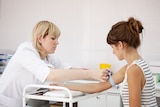Currently, over 25% of individuals undergoing cervical screening are choosing to self-collect samples instead of relying on a healthcare provider.
Understanding the Contrast Between DIY Swab and Pap Smear
Exploring the realm of cervical screening, particularly through self-collection HPV tests, revealed intriguing insights. In mid-2022, a notable shift occurred in eligibility criteria, leading to 13,728 individuals opting for DIY cervical screening HPV tests. This number significantly rose in the last quarter of 2023, with 87,913 patients embracing this self-collection approach.
Among these individuals was Mikayla Wolfe, a 25-year-old research assistant from Melbourne, who participated in a self-collection event to conduct her own DIY cervical screening HPV test. Reflecting on her experience, she shared, “I experienced a mix of nervousness and empowerment while performing the test. It allowed me to take control of the process, conducting it at my own pace and in a manner that suited me.”

The Experience of DIY Cervical Screening for HPV
Mikayla Wolfe took charge of her own cervical screening test, a process known as self-collection, to increase uptake in the LGBTQIA+ community. Despite her prior research in this area, it was her first personal experience with the test.
Reflecting on her self-collection experience, Ms. Wolfe admitted to initial hesitancy, noting that handling the small swab was a bit challenging at first. However, she quickly adapted, realizing the convenience of conducting the test at her own pace.
While the self-collection method differs from the traditional healthcare provider-administered test, the accuracy and reliability of the results remain consistent. Patients are provided with detailed instructions to facilitate the self-testing process.
During self-collection, individuals swab their vagina for 30 seconds using a kit similar to a PCR COVID test. In contrast, healthcare professionals typically collect samples from the cervix during a speculum examination.
Historically, patients were advised to undergo pap smears every two years until 2017 when the recommendation shifted to the more advanced cervical screening test every five years. This change aims to enhance early detection of potential abnormalities.
According to the Cancer Council, the transition from biennial pap smears to five-yearly cervical screening is based on the understanding that persistent HPV infections may take 10 to 15 years to develop into cervical cell changes that could lead to cancer.
Empowering Individuals with DIY Cervical Screening for HPV
Individuals who were previously underserved are taking the lead in embracing the self-screening option for cervical cancer.
Specific patient demographics show notably high participation rates:
- Residents in very remote areas: 51%
- Individuals in the Northern Territory: 47%
- Individuals aged 70 and above: 34%
- Financially disadvantaged individuals: 29%
Research conducted by Ms. Wolfe revealed that healthcare professionals noted that self-collection of samples seemed to provide LGBTQIA+ patients with a heightened sense of empowerment and independence.
Marion Saville, the Executive Director of the Australian Centre for Prevention of Cervical Cancer, emphasized that the introduction of self-screening has enhanced accessibility for many individuals who previously avoided testing.

Patients have the option to utilize the kit either at a GP clinic or, in certain situations, in the comfort of their own homes. According to ABC News’ Claudia Long, the DIY cervical screening HPV kit offers a significant advancement in accessibility and acceptability. The traditional model of undergoing a pelvic exam with a speculum at a healthcare provider’s office was found to be unsuitable for many individuals in the community, especially those with cultural sensitivities or a history of sexual trauma. This innovative approach addresses the barriers that previously deterred people from participating in cervical cancer screening, making it a game changer in reaching a broader audience.
DIY Cervical Screening HPV: Achieving Feasible Elimination
Explore More on DIY Cervical Screening HPV
Understanding the Impact of a Recent Report on Health Care: From DIY Cervical Screening HPV to Accessible Abortion and Contraception Incentives

Upcoming Modifications in Abortion Laws Aim to Enhance Accessibility
DIY cervical screening HPV

The necessity of governmental support for copper IUDs, according to experts

To learn more about DIY cervical screening HPV, explore additional topics such as Australia, Cervical and Vulval Cancers, Federal Government, Public Health, and Women’s Health. Please visit our site 60time.com for further information. Don’t forget to follow us on social media at [email protected].


